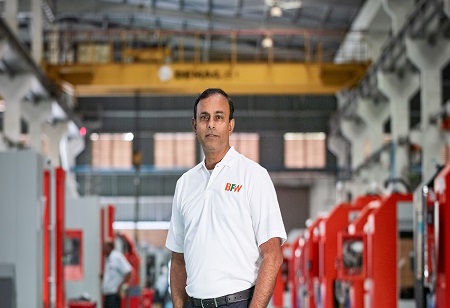
Excerpts from an interaction with Raghavan, Managing Director, Bharat Fritz Werner. He is an engineer with a management degree and has 33 years of Operational and Strategic experience in Engineering and Manufacturing.
What are the major challenges in applying the principles of lean manufacturing to a business environment?
The fundamental steps of lean manufacturing such as identifying the value, mapping the value stream, creating an uninterrupted flow, establishing pull & seeking perfection through continuous improvement are all very much applicable to business environments. However, I feel the challenge is in its ability to visualize the value in critical business practices & thereby gaps in mapping realistic value streams. The volatility in business scenarios arising out of factors that are not in the circle of control limits the businesses to enable uninterrupted flow.
How can a business identify waste and inefficiency in a manufacturing process, and what steps can be taken to eliminate or reduce it?
There are many ways to address this. One of the effective ways is to first standardize the processes, do a thorough mapping of the value stream, and compare it with best/next practices in the industry (within & outside), which should encapsulate people, processes & technology. While doing this the obvious inefficiencies/ineffectiveness will get exposed which can be identified as ‘waste’. It will also provide insights into various options to eliminate/minimize waste.
What role do continuous improvement and standardized work play in implementing lean manufacturing principles?
Continuous improvement creates a great culture in any organization since it creates a paradigm shift in the mindsets of people where growth takes center stage which is so important in this VUCA world. Standardized work is essential in any manufacturing setup wherever there are repetitive jobs. It brings consistency & transparency to outcomes which are crucial in manufacturing.
How can a business measure the success of its lean manufacturing initiatives and make adjustments as necessary?
Having KPIs aligned to business objectives with a lean framework is the starting point. Then breaking down those into palatable KAI’s at each process step of a value chain provides the impetus to align activities with objectives. After that, it is just relentless execution with meticulous reviews. Ways & means to achieve objectives will eventually evolve/get refined as we move along. But this process is the key to success.
How important are employee buy-in and participation in implementing lean manufacturing, and what strategies can be used to encourage engagement at all levels of the organization?
‘Total employee engagement’ is the basic fabric of any excellence journey. An effective way to promote it is by making everyone in the organization realize the purpose of what we wish to accomplish. Like at BFW, everything we do is to ‘Enable Progress’. Progress of all stakeholders. The same is applicable to lean initiatives as well. Promoting innovation in very simple aspects of daily work, appreciating small successes, accommodating failures as a part of the journey & demonstrating role model behavior by business leaders. All these help to engage people at all levels in an organization.
A well-designed digital dashboard helps businesses to take agile business decisions on a real-time basis thus moving from a reactive mode to a proactive mode.
We use cookies to ensure you get the best experience on our website. Read more...